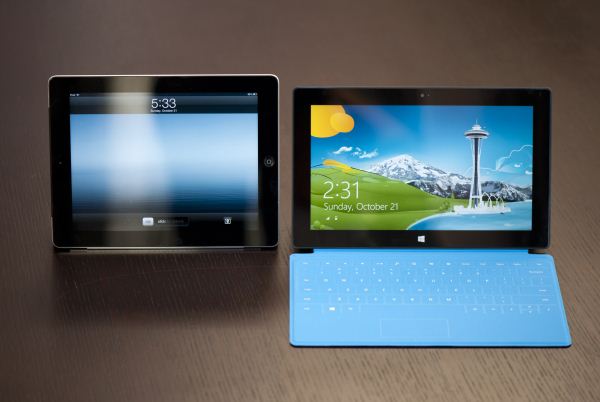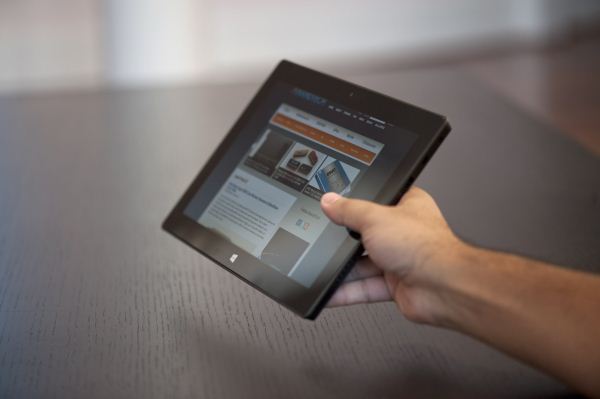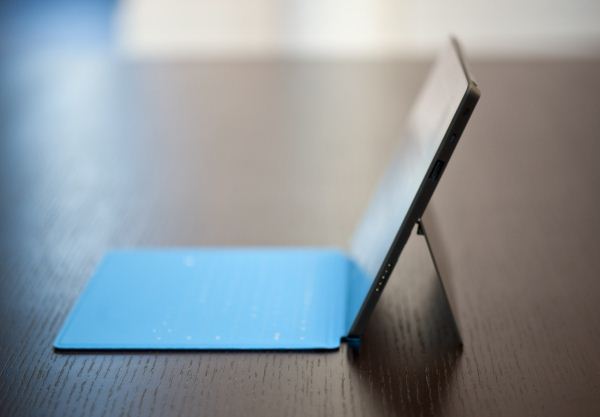Microsoft Surface Review
by Anand Lal Shimpi on October 23, 2012 9:01 PM EST- Posted in
- Tablets
- Microsoft
- Mobile
- Surface
- Windows RT
Surface: Simply Put
Surface is very well built and extremely well designed. It’s easily among the best built products I’ve had the opportunity to handle, and definitely puts a lot of earlier attempts from far more experienced companies to shame. I wouldn’t say that it looks better or worse than the iPad, it’s simply different. I talked about perspectives earlier, Microsoft’s perspective on tablets is a bit more utilitarian than Apple’s and Surface’s design reflects that reality.
Where the iPad is curvy and without any IO expansion, Surface is squared off with 22-degree beveled edges. The iPad features a light aluminum finish while Surface contrasts with its dark Magnesium surface. Not better or worse, just different.
Surface is both larger and heavier than the iPad, both design decisions on Microsoft’s part to built a device that could better deal with Windows RT’s multitasking capabilities as well as make room for a comfortable typing area when used with one of its two keyboard covers.
The added weight is offset by superb internal weight distribution. Microsoft claims a lower moment of inertia by more evenly distributing weight inside Surface’s chassis. I don’t know that I’d consider Surface light but it is very comfortable to carry around. It’s not quite like porting around a pad of paper, but carrying Surface feels very natural.
The focus on weight distribution results in a device that is honestly comfortable to hold in tablet mode and very comfortable to carry around. The more squared design of Surface actually makes in hand feel more like a book than the iPad, which was an early goal for the device.
The chassis is built out of an injection molded Magnesium, which gives it a very different feel to most machined Aluminum or plastic tablets we’ve used in the past. Microsoft calls this process VaporMg (vapor-mag) and I have to say that I’m pleased with the outcome. Surface’s finish is smooth and lacks the same texture that we’ve come to expect from machined Aluminum. The device feels very durable and doesn’t seem to scratch or scuff easily, although I didn’t purposefully try to mar my review unit over the past week. Striking a balance between robustness and light weight is very tricky business when building mobile devices, Surface easily falls on the robust side of the scale without feeling overly heavy. I never felt that the device was too fragile.
The power of Surface is in its flexibility. Microsoft’s talents not as a software developer nor as a parts assembler are what make Surface great here, rather its design and manufacturing intuition. I would’ve expected Surface to come from a company that had much more experience in designing and building tablets and PCs, not from a company that’s traditionally known for putting stickers all over them.
Surface’s flexibility comes from three areas: the tablet itself, the integrated kickstand and the optional Touch/Type covers. In tablet mode, Surface is Microsoft’s take on the new wave of tablets. It delivers the same intimate content consumption experience that you’d get from other tablets but with the added benefits of Windows RT, such as improved multitasking and better task switching.
Surface also features an integrated kickstand, also made out of the same VaporMg process as the rest of the chassis.
Microsoft wants you to be able to quickly transition between notebook, tablet and display modes. It’s rare that I see a goal so well executed. Surface really masters the art of quick transitions between all three modes. I can be in word, typing out this review and quickly switch to a tablet mode where I’m browsing the web with the keyboard cover folded neatly behind the display. If I need to respond to a comment or answer an email, I can just as easily switch back. The kickstand is a necessary part of enabling these quick transitions, and it does its job well.
There’s only one side of Surface that has a cutout for you to easily flick the stand out from its resting place. The kickstand’s range of motion does take some getting used to. It’s spring loaded enough to pop out at good velocity (and strong enough to pinch your skin nicely if you close it on a part of your finger by accident). When deployed it positions the top of Surface away from you at a 22-degree angle, matching the bevel of Surface’s edge.
With a fixed angle of deployment the kickstand doesn’t always deliver the best viewing experience, although it’s usually good enough. The kickstand is perfect for desk use and even for using while reclined on a couch or even in bed. Where it does fall short is if you’re hunched over Surface on an airplane in coach without a lot of room to move the device away from you. In those situations you’re going to find that you’d wish the kickstand could open at a wider angle.
Microsoft is particularly proud of the acoustics and feel of the kickstand. In my experience I felt the kickstand actuated nicely but I don’t know if I’d go so far as to draw the luxury car door comparison. The best way I can put it is the kickstand never feels cheap and doesn’t rattle, it works and gives you the confidence that it’ll always work and not just break after half a year. It’s not often that I find a substantial moving part on a mobile device that I feel is more functional than gimmicky. Surface’s kickstand is definitely a job well done.
The third element of Surface that makes it a very flexible device is also responsible for the splash of color in the design that gives the otherwise business appearance a consumer twist. I’m talking about Surface’s Type and Touch Covers.



















235 Comments
View All Comments
MadMan007 - Tuesday, October 23, 2012 - link
Nice article, but something struck me as odd after getting a bit into it - why do you refer to this device as 'Surface' as if it's a person instead of 'THE Surface' like every other device? Are we going to start seeing reviews saying 'I like Macbook's new screen'?melgross - Wednesday, October 24, 2012 - link
Apple does the same thing with the iPad, simply referring to is as iPad. I don't understand this either, but it's their choice.jjj - Tuesday, October 23, 2012 - link
pushing the positive spin quite a bit on this one.NO ecosystem, buggy software ,can't be used with the keyboard on your lap like the Transformer or any laptop,poor keyboard , high price,the software takes a lot of the advertised storage,access to only one app store and bulky hardware.
guidryp - Wednesday, October 24, 2012 - link
Yeah. I read several other reviews (Verge, Wired, Tech Crunch) and this one seems like a whitewash in comparison.Most point out that there is very little software and most of it is buggy. They also mention how uncomfortable it is to use as a tablet.
Half assed as a tablet.
Half assed as laptop.
Very little software...
Buggy
For MS/Windows fans, at least get yourself an x86 so you can run real Windows software to cover the deficiencies.
doobydoo - Wednesday, October 24, 2012 - link
Did I miss the CPU / GPU benchmarks section, which generally come with every tablet review?tipoo - Wednesday, October 24, 2012 - link
There probably aren't that many that can be run outside of a web browser for it, the app store is pretty sparse right now.michal1980 - Wednesday, October 24, 2012 - link
Anand is showing that he cares far less about MS now then apple.kyuu - Thursday, October 25, 2012 - link
Nope. But there's not much benchmarking software that can be run on WindowsRT, outside of web-based ones. Plus, Tegra 3 is a pretty known quantity at this point.trexpesto - Tuesday, October 23, 2012 - link
one heck of a drop test 30,000 feet!glynor - Tuesday, October 23, 2012 - link
So... I'm seeing mixed information out there. The port looks like a regular micro-HDMI port. But Microsoft seems to call it a proprietary port in their marketing, and they sell the adapter.But PC Mag says they used an off-the-shelf micro-HDMI adapter and it worked.
But then, you got terrible (I'd call it unusable) quality out of their adapter.
What's going on here?